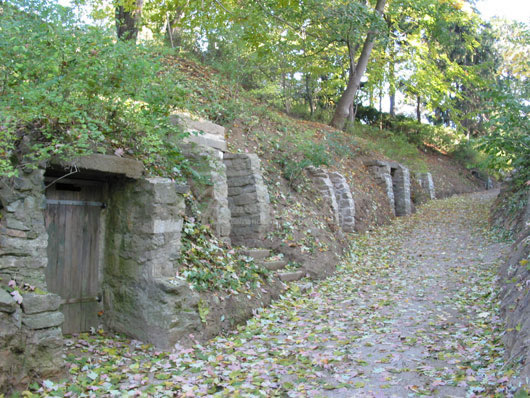
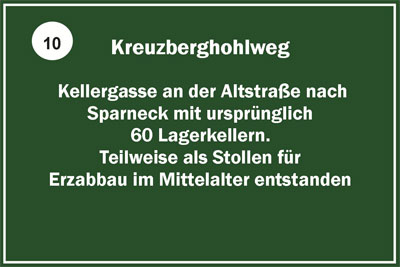
Building Number 10 in the printed brochure
“Historic Buildings in Münchberg”.
The sign is down, at the beginning of the ravine.
The Historic Münchberg Way leads over the optional stations O5 to O11 back to the city park, but here in the Kreuzberg (English: cross hill) Ravine the shorter main route ends. Therefore, at this station feedback can be given in a cellar on the right in the upper part.
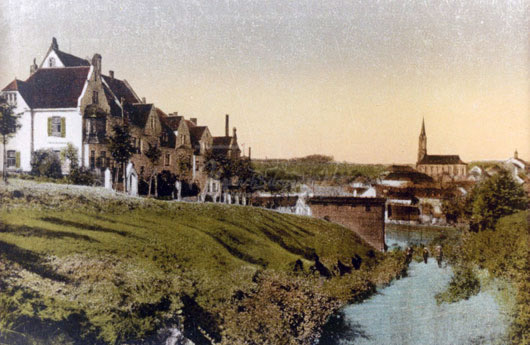 At the same time, we are on the historical ground, which brings together important points of the Münchberg past. In the middle Ages this connecting road was traveled by oxcarts and was described at that time as “quite a terrible hollow”. Three chapels in front of the city gates (St. Dietrich Stammbach direction, St. Gangolf Hof direction, and the Little Church of the Holy Cross, which presumably stood in the ravine and gave the ravine its name) made it possible to pray for a successful journey and to give thanks for it at the end in the other chapel.
At the same time, we are on the historical ground, which brings together important points of the Münchberg past. In the middle Ages this connecting road was traveled by oxcarts and was described at that time as “quite a terrible hollow”. Three chapels in front of the city gates (St. Dietrich Stammbach direction, St. Gangolf Hof direction, and the Little Church of the Holy Cross, which presumably stood in the ravine and gave the ravine its name) made it possible to pray for a successful journey and to give thanks for it at the end in the other chapel.
The eastern cellars in the ravine may have originated from old excavation sites (15th century) for ore mining, and thus are a testimony to mining in and around Münchberg. Gold, silver and copper were mined.
The ravine is a still existing part of a historic street, at that time an important connection between Münchberg and Sparneck, respectively the Waldstein Castle. Thus, this still preserved monument recalls the time of the rule of the knights of Sparneck (around the 14th century), which for the inhabitants of the city of Münchberg was more than significant.
The side flanks of the ravine cellars were built as storerooms for provisions. In the still preserved part there are around 60 cellars, on the eastern side even double decked over each other. Along with the barn rows, they are a testimony of the agricultural period (around the end of the 18th century) in which the inhabitants of the city still operated their agriculture and farmed along with their handcrafts.
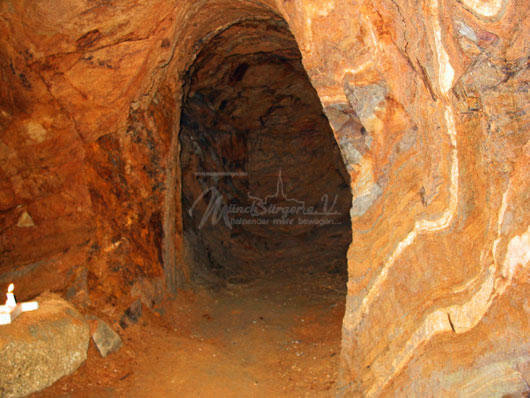 Also, the rock cellars were used as beer depositories in later times. An existing cellar still shows the beer benches necessary for the barrel storage. Along with beer, ice was also stored around 1900. The “ice cellar”, meanwhile abandoned (brick building, in both old photos) is a stopping pint for this. Its entry steps exist yet.
Also, the rock cellars were used as beer depositories in later times. An existing cellar still shows the beer benches necessary for the barrel storage. Along with beer, ice was also stored around 1900. The “ice cellar”, meanwhile abandoned (brick building, in both old photos) is a stopping pint for this. Its entry steps exist yet.
In the Second World War a few of the ravine cellars were converted to shelters.
The Kreuzberg Ravine with its rock cellars was cleaned up and renovated by the Münchbergers, so that in 2003 it could finally be officially opened in its redesigned form. Today the rock caves serve as winter quarters for bats and can be visited in summer on guided tours. In some cases you can find interesting stone formations (photo left) on the walls of the cellar. Some vaults are supported with arches for aesthetic reasons. Due to danger of collapsing, some of the entrances have had to be closed off with stone walls in recent years.
More information and pictures of the Kreuzberg Ravines can be found on the project pages of the MünchBürger and on the info boards next to the railway bridge on Bayreuther Straße, through which the Historic Münchberg Way also leads./p>
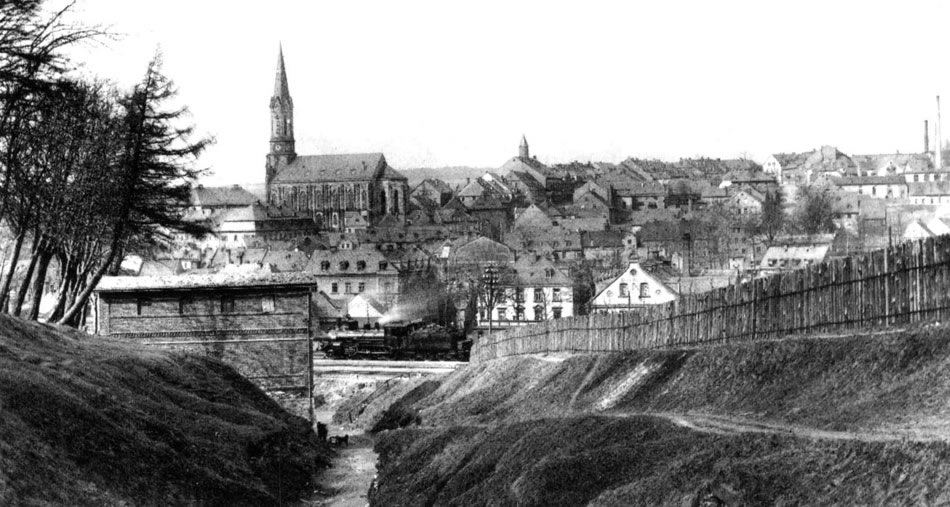
Video: Aerial view Kreuzberg Ravine
Copywriters, authors, photographers, rights holders or sources:
Rainer Fritsch, Sandy Schroeder, Markus Jennermann, city archives
Audio file

